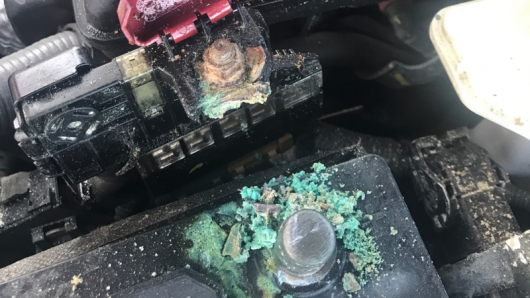How to deal with white and blue patina around the battery terminals
What does the plaque on the battery terminals and how to fight it?
I am sure that once you ran the engine from the battery of another car or change the battery, you could notice terminals or the bluish green substance resembling powder. What is it? From what it appears? You can eat it? Let’s find out.
First, there is, of course not, you would be wrong. Don’t do it.
Corrosion is a very common phenomenon and almost all cars with a lead battery this subject. Corrosion develops quite quickly and not necessarily just on unattended machines that are not used by years. Let’s see, what are the terminals of the Nissan Rogue 2014.

So, what is it and what is the cause? It all depends on what terminal was there corrosion on the negative or positive.
As pictured above — the positive terminal, then to begin with. This greenish-blue mass — most likely, sulphate of copper, which gained this kind of exposure to moisture. It is formed when the copper in the contact terminal reacts with the copper in the battery terminal. The reaction is enhanced by the transmission of electric current and exposure to sulfuric acid, which seeps from the inside of the battery.
A chemical reaction can be expressed by the following formula:
Cu (s) + 2 H2SO4 (l) → CuSO4 (aq) + 2 H2O (l) + SO2 (g)
Copper sulfate is not a very good conductor of electricity, so often spoils the battery (and you have other problems with electricity). It is therefore a good idea to clean this stuff off the terminals. In this business helps ordinary baking soda and water. The baking soda will neutralize the copper sulphate.
If you are around negative terminals you see corrosion in the form of a powder, that is another matter and the reason for its formation is also different. White powder is the result of a process called “sulfation”. The usual cause of sulfation is the fact that the lead battery was not fully charged.
This can happen if the machine is normally used only for short journeys, especially if you have a modern car that consumes a lot of electricity. Modern machines have a large number of auxiliary electronics, and if you make only short trips, this is not always enough to restore the battery charge.
As a result, the sulfation. Experts give a definition of sulfation:
During use, the formation of small sulfate crystals, but this is normal, and the crystals absolutely not harm the battery. However, when the battery for a long period of time can not be charged, the copper sulfate turns into a stable crystal structure and is deposited on the negative plates of the battery. This leads to the development of large crystals, which reduce the amount of active material of the battery, responsible for his work.
Usually there are two types of sulfation: reverse (soft) and permanent (hard). I bet you have already guessed, what is the difference between these two types of sulfation. Reverse sulfation occurs at the beginning and usually this process is reversible if a fully charged battery leave a bit to charge. Permanent sulfation is the result of prolonged insufficient charging of the battery, and there’s nothing you can do.
Don’t know if this helps you, but here is the formula of a chemical reaction between copper and sulfuric acid:
Pb (s) + H2SO4 (aq) → PbSO4 (aq) + H2 (g)
Mostly affects sulfation of the internal plates of the battery, but the leakage of sulfuric acid in the location where the terminal (usually zinc and copper) joined to the plastic casing of the battery can lead to sulfation on the outside. If you read what I write on this network, it causes corrosion of the battery terminals is a huge number, including the release of hydrogen gas. Of course, batteries can provide some amount of hydrogen, however, it is unlikely that this is the main reason of the corrosion.
So, to sum up. Bluish stuff around the positive terminal is most likely copper sulphate. If around the aluminum clamps have accumulated a white substance, it could be aluminum sulfate. In any case, it is a reaction between dissimilar metals, reinforced electricity and the leakage of sulfuric acid from the battery.

Corrosion around the negative terminal manifest in the form of a white/gray/ light yellow substance, and this is the result of insufficient charging of the battery, which leads to sulfation.
One of our sponsors, the Jeep battery was constantly charged insufficient, and the corrosion around the negative terminal was so strong that I had to replace the ground wire. This was another Jeep with a recharged battery. If the negative terminal was clean, the positive terminal was covered in green stuff.
I hope the article was all clear and she was helpful. Just try to keep the terminals clean. Now you can buy special products that help to prevent corrosion, the results are different. Before recommending you something, I need to test these products.
